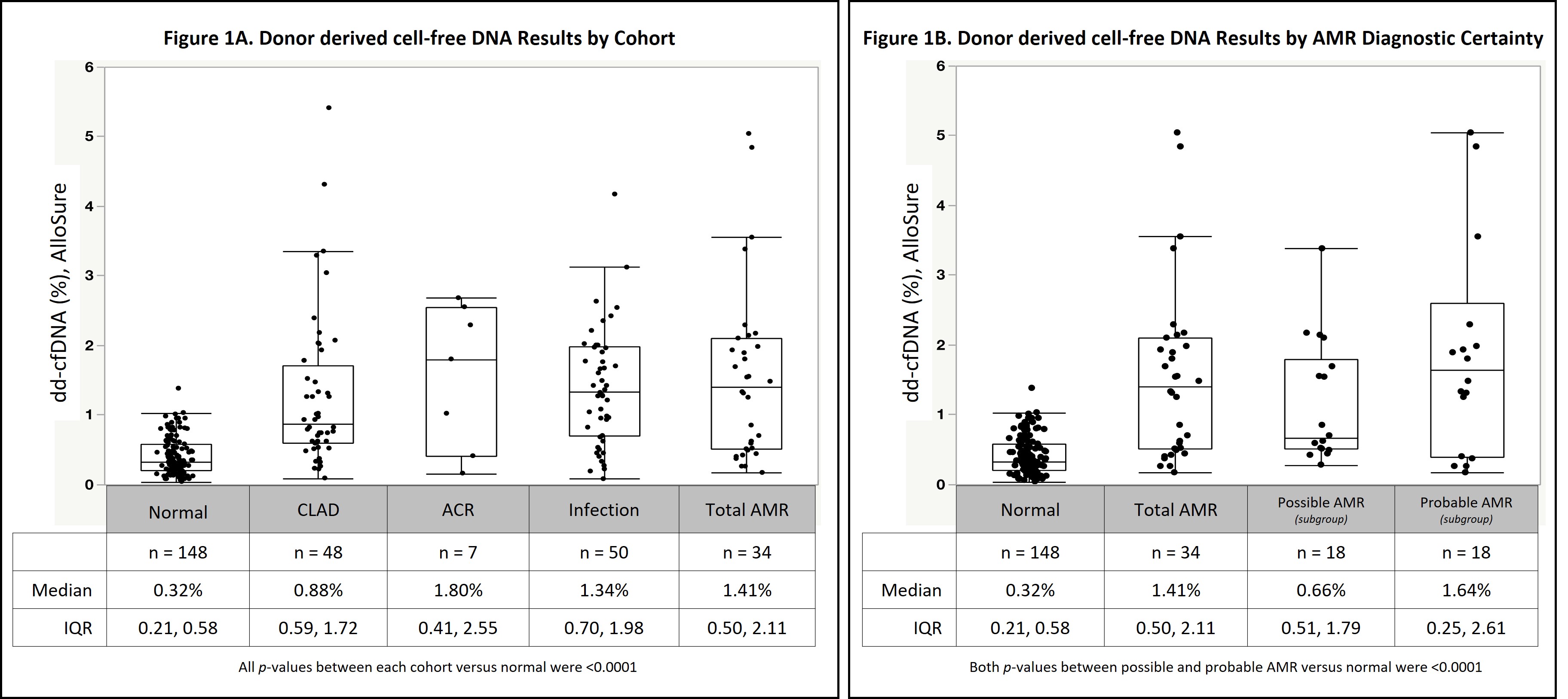dd-cfDNA Varies Among Diagnostics Groups of Pulmonary AMR
1University of Texas Health System San Antonio, San Antonio, TX, 2CareDX, South San Francisco, CA, 3CareDx, South San Francisco, CA, 4Pneumology, Adult CF Center and Lung Transplantation Department, Foch Hospital, Suresnes, France
Meeting: 2022 American Transplant Congress
Abstract number: 1487
Keywords: Antibodies, Genomic markers, Lung transplantation, Non-invasive diagnosis
Topic: Clinical Science » Lung » 64 - Lung: All Topics
Session Information
Session Time: 7:00pm-8:00pm
 Presentation Time: 7:00pm-8:00pm
Presentation Time: 7:00pm-8:00pm
Location: Hynes Halls C & D
*Purpose: Antibody mediated rejection (AMR) in lung transplant remains complex, with differential diagnosis often overlapping with other causes of lung dysfunction. Diagnostic certainty declines to probable or possible as fewer defining characteristics are present. Donor derived cell-free DNA (dd-cfDNA) is a marker of graft injury, which has the potential to distinguish between possible and probable AMR.
*Methods: We reviewed AMR episodes in lung transplant recipients (LTRs) with paired dd-cfDNA (AlloSure) samples drawn between 5/2019 and 6/2021. All AMR episodes were assessed for concurrent events and categorized per ISHLT consensus definitions. To reflect the complicated clinical presentation of AMR, all AMR samples were included regardless of concurrent ACR, CLAD, or infection. The primary endpoint was dd-cfDNA across cohorts.
*Results: Dd-cfDNA was significantly increased in patients with CLAD, ACR, infection, or AMR compared to a normal cohort. Thirty-four AMR samples were identified, with 18 (50%) samples in each possible or probable group. There were no definite AMR cases. All ‘possible AMR’ were subclinical; the only criteria being circulating DSA. Median dd-cfDNA was 1.41% in the total AMR group, 0.66% in possible, and 1.64% in probable. A distinct gap was observed within AMR dd-cfDNA results between ≥1.25% and ≤0.85%; only 39% (7/18) possible AMR dd-cfDNA versus 72% (13/18) probable were >0.85%. Median dd-cfDNA in both AMR groups were elevated compared to a normal cohort (0.32%) (p<0.001).
*Conclusions: AMR regardless of concurrent diagnoses had elevated dd-cfDNA relative to normal; possible AMR had much lower dd-cfDNA than probable. A larger percentage of samples in the possible group were in a cluster with dd-cfDNA <0.85%. Elevated dd-cfDNA is associated with graft injury, therefore further investigation of the trends observed here could provide insight into the complicated presentation of AMR. Dd-cfDNA may help overcome the challenge of defining AMR in the face of concurrent diagnoses.
To cite this abstract in AMA style:
Levine D, Giner C, Pham C, Woodward R, Roux A. dd-cfDNA Varies Among Diagnostics Groups of Pulmonary AMR [abstract]. Am J Transplant. 2022; 22 (suppl 3). https://atcmeetingabstracts.com/abstract/dd-cfdna-varies-among-diagnostics-groups-of-pulmonary-amr/. Accessed December 22, 2025.« Back to 2022 American Transplant Congress

